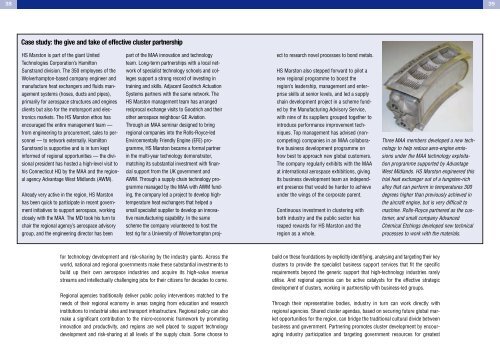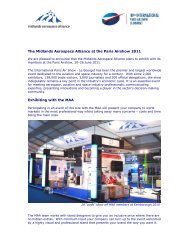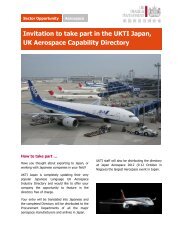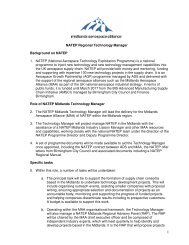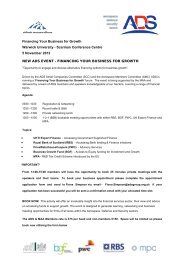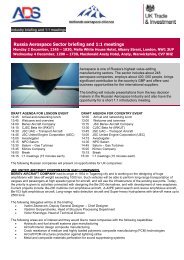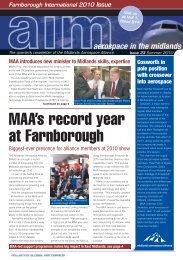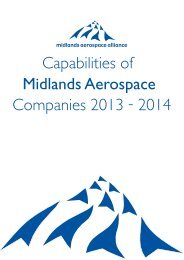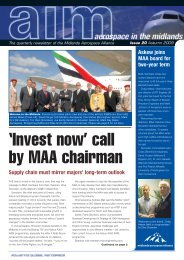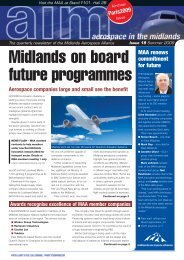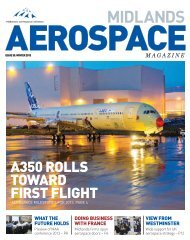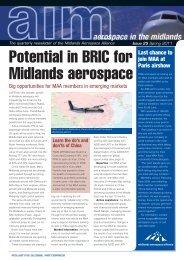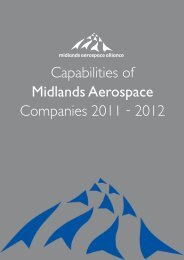Mobilising the Midlands aerospace cluster
Mobilising the Midlands aerospace cluster
Mobilising the Midlands aerospace cluster
- No tags were found...
You also want an ePaper? Increase the reach of your titles
YUMPU automatically turns print PDFs into web optimized ePapers that Google loves.
38<br />
39<br />
Case study: <strong>the</strong> give and take of effective <strong>cluster</strong> partnership<br />
HS Marston is part of <strong>the</strong> giant United<br />
Technologies Corporation’s Hamilton<br />
Sunstrand division. The 350 employees of <strong>the</strong><br />
Wolverhampton-based company engineer and<br />
manufacture heat exchangers and fluids management<br />
systems (hoses, ducts and pipes),<br />
primarily for <strong>aerospace</strong> structures and engines<br />
clients but also for <strong>the</strong> motorsport and electronics<br />
markets. The HS Marston ethos has<br />
encouraged <strong>the</strong> entire management team —<br />
from engineering to procurement, sales to personnel<br />
— to network externally. Hamilton<br />
Sunstrand is supportive and is in turn kept<br />
informed of regional opportunities — <strong>the</strong> divisional<br />
president has hosted a high-level visit to<br />
his Connecticut HQ by <strong>the</strong> MAA and <strong>the</strong> regional<br />
agency Advantage West <strong>Midlands</strong> (AWM).<br />
Already very active in <strong>the</strong> region, HS Marston<br />
has been quick to participate in recent government<br />
initiatives to support <strong>aerospace</strong>, working<br />
closely with <strong>the</strong> MAA. The MD took his turn to<br />
chair <strong>the</strong> regional agency’s <strong>aerospace</strong> advisory<br />
group, and <strong>the</strong> engineering director has been<br />
part of <strong>the</strong> MAA innovation and technology<br />
team. Long-term partnerships with a local network<br />
of specialist technology schools and colleges<br />
support a strong record of investing in<br />
training and skills. Adjacent Goodrich Actuation<br />
Systems partners with <strong>the</strong> same network. The<br />
HS Marston management team has arranged<br />
reciprocal exchange visits to Goodrich and <strong>the</strong>ir<br />
o<strong>the</strong>r <strong>aerospace</strong> neighbour GE Aviation.<br />
Through an MAA seminar designed to bring<br />
regional companies into <strong>the</strong> Rolls-Royce-led<br />
Environmentally Friendly Engine (EFE) programme,<br />
HS Marston became a formal partner<br />
in <strong>the</strong> multi-year technology demonstrator,<br />
matching its substantial investment with financial<br />
support from <strong>the</strong> UK government and<br />
AWM. Through a supply chain technology programme<br />
managed by <strong>the</strong> MAA with AWM funding,<br />
<strong>the</strong> company led a project to develop hightemperature<br />
heat exchangers that helped a<br />
small specialist supplier to develop an innovative<br />
manufacturing capability. In <strong>the</strong> same<br />
scheme <strong>the</strong> company volunteered to host <strong>the</strong><br />
test rig for a University of Wolverhampton proj-<br />
ect to research novel processes to bond metals.<br />
HS Marston also stepped forward to pilot a<br />
new regional programme to boost <strong>the</strong><br />
region’s leadership, management and enterprise<br />
skills at senior levels, and led a supply<br />
chain development project in a scheme funded<br />
by <strong>the</strong> Manufacturing Advisory Service,<br />
with nine of its suppliers grouped toge<strong>the</strong>r to<br />
introduce performance improvement techniques.<br />
Top management has advised (noncompeting)<br />
companies in an MAA collaborative<br />
business development programme on<br />
how best to approach new global customers.<br />
The company regularly exhibits with <strong>the</strong> MAA<br />
at international <strong>aerospace</strong> exhibitions, giving<br />
its business development team an independent<br />
presence that would be harder to achieve<br />
under <strong>the</strong> wings of <strong>the</strong> corporate parent.<br />
Continuous investment in <strong>cluster</strong>ing with<br />
both industry and <strong>the</strong> public sector has<br />
reaped rewards for HS Marston and <strong>the</strong><br />
region as a whole.<br />
Three MAA members developed a new technology<br />
to help reduce aero-engine emissions<br />
under <strong>the</strong> MAA technology exploitation<br />
programme supported by Advantage<br />
West <strong>Midlands</strong>. HS Marston engineered this<br />
trial heat exchanger out of a tungsten-rich<br />
alloy that can perform in temperatures 300<br />
degrees higher than previously achieved in<br />
<strong>the</strong> aircraft engine, but is very difficult to<br />
machine. Rolls-Royce partnered as <strong>the</strong> customer,<br />
and small company Advanced<br />
Chemical Etchings developed new technical<br />
processes to work with <strong>the</strong> materials.<br />
for technology development and risk-sharing by <strong>the</strong> industry giants. Across <strong>the</strong><br />
world, national and regional governments make <strong>the</strong>se substantial investments to<br />
build up <strong>the</strong>ir own <strong>aerospace</strong> industries and acquire its high-value revenue<br />
streams and intellectually challenging jobs for <strong>the</strong>ir citizens for decades to come.<br />
Regional agencies traditionally deliver public policy interventions matched to <strong>the</strong><br />
needs of <strong>the</strong>ir regional economy in areas ranging from education and research<br />
institutions to industrial sites and transport infrastructure. Regional policy can also<br />
make a significant contribution to <strong>the</strong> micro-economic framework by promoting<br />
innovation and productivity, and regions are well placed to support technology<br />
development and risk-sharing at all levels of <strong>the</strong> supply chain. Some choose to<br />
build on <strong>the</strong>se foundations by explicitly identifying, analysing and targeting <strong>the</strong>ir key<br />
<strong>cluster</strong>s to provide <strong>the</strong> specialist business support services that fit <strong>the</strong> specific<br />
requirements beyond <strong>the</strong> generic support that high-technology industries rarely<br />
utilise. And regional agencies can be active catalysts for <strong>the</strong> effective strategic<br />
development of <strong>cluster</strong>s, working in partnership with business-led groups.<br />
Through <strong>the</strong>ir representative bodies, industry in turn can work directly with<br />
regional agencies. Shared <strong>cluster</strong> agendas, based on securing future global market<br />
opportunities for <strong>the</strong> region, can bridge <strong>the</strong> traditional cultural divide between<br />
business and government. Partnering promotes <strong>cluster</strong> development by encouraging<br />
industry participation and targeting government resources for greatest


